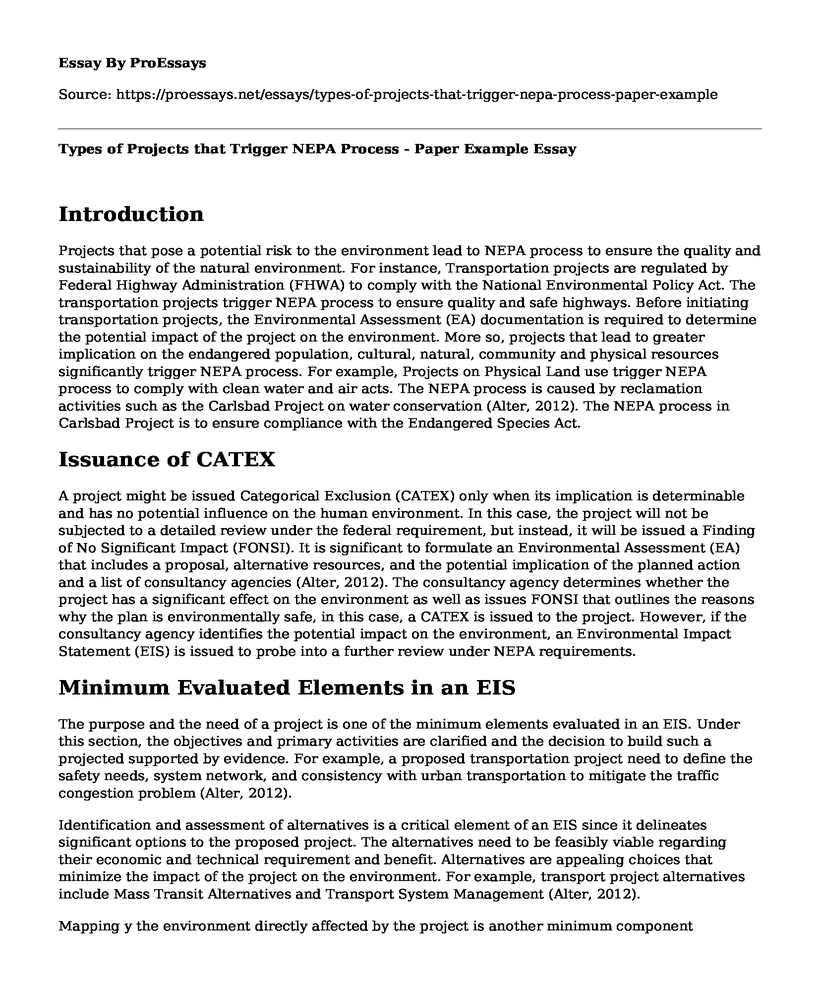Introduction
Projects that pose a potential risk to the environment lead to NEPA process to ensure the quality and sustainability of the natural environment. For instance, Transportation projects are regulated by Federal Highway Administration (FHWA) to comply with the National Environmental Policy Act. The transportation projects trigger NEPA process to ensure quality and safe highways. Before initiating transportation projects, the Environmental Assessment (EA) documentation is required to determine the potential impact of the project on the environment. More so, projects that lead to greater implication on the endangered population, cultural, natural, community and physical resources significantly trigger NEPA process. For example, Projects on Physical Land use trigger NEPA process to comply with clean water and air acts. The NEPA process is caused by reclamation activities such as the Carlsbad Project on water conservation (Alter, 2012). The NEPA process in Carlsbad Project is to ensure compliance with the Endangered Species Act.
Issuance of CATEX
A project might be issued Categorical Exclusion (CATEX) only when its implication is determinable and has no potential influence on the human environment. In this case, the project will not be subjected to a detailed review under the federal requirement, but instead, it will be issued a Finding of No Significant Impact (FONSI). It is significant to formulate an Environmental Assessment (EA) that includes a proposal, alternative resources, and the potential implication of the planned action and a list of consultancy agencies (Alter, 2012). The consultancy agency determines whether the project has a significant effect on the environment as well as issues FONSI that outlines the reasons why the plan is environmentally safe, in this case, a CATEX is issued to the project. However, if the consultancy agency identifies the potential impact on the environment, an Environmental Impact Statement (EIS) is issued to probe into a further review under NEPA requirements.
Minimum Evaluated Elements in an EIS
The purpose and the need of a project is one of the minimum elements evaluated in an EIS. Under this section, the objectives and primary activities are clarified and the decision to build such a projected supported by evidence. For example, a proposed transportation project need to define the safety needs, system network, and consistency with urban transportation to mitigate the traffic congestion problem (Alter, 2012).
Identification and assessment of alternatives is a critical element of an EIS since it delineates significant options to the proposed project. The alternatives need to be feasibly viable regarding their economic and technical requirement and benefit. Alternatives are appealing choices that minimize the impact of the project on the environment. For example, transport project alternatives include Mass Transit Alternatives and Transport System Management (Alter, 2012).
Mapping y the environment directly affected by the project is another minimum component evaluated in an EIS to determine the environmental implications of the project and each proposed alternatives (Luther, 2003). Under this component, demographic data on potential population affected by the project is determined as well as the social, economic and environmental setting on the suggested area.
Environmental implications are then ascertained to determine the project's legal compliance. The consequences include both the social, economic, and ecological merits and demerits of the project and its proposed alternatives. The implication to the environment is categorized as either direct or indirect consequences. Furthermore, the environmental impact component highlights measures that minimize the adverse project consequences. For example, the environmental impacts of a transportation project include effects on natural land use, relocation, and social consequences (Alter, 2012).
Agency cooperation and comments is another significant component of an EIS which defines the lead agency responsible for preparing NEPA documentation. In this, the lead agency is the federal agency. Besides listing the lead agency, an EIS lists collaborating agencies as well as their respective comments regarding the proposed project's impacts, and alternatives (Luther, 2003). The comments by the lead agency and collaborating agencies lead to project alternative modification, improvement, and supplementation to minimize the impact on the environment.
References
Alter, B. (2012). Environmental consulting fundamentals: Investigation and remediation. Boca Raton, FL: CRC Press.
Luther, L. (2003, August). Background on NEPA Implementation for Highway Projects: Streamlining the Process. Congressional Research Service, Library of Congress.
Cite this page
Types of Projects that Trigger NEPA Process - Paper Example. (2022, Jul 11). Retrieved from https://proessays.net/essays/types-of-projects-that-trigger-nepa-process-paper-example
If you are the original author of this essay and no longer wish to have it published on the ProEssays website, please click below to request its removal:
- Coal Mining in Appalachia
- Climate and Weather Change Articles Review Paper Example
- Article Analysis Essay on Wastewater Reuse for Irrigation: Nutrient Recovery & Waste Disposal
- Preventing Fire Outbreaks: Protecting Lives, Property, and the Economy - Essay Sample
- Cultural Anthropology: Exploring Societies and Cultures - Essay Sample
- Say No to Plastic Straws: Why We Need to Act Now - Essay Sample
- Paper on Companies and Environmental Sustainability







